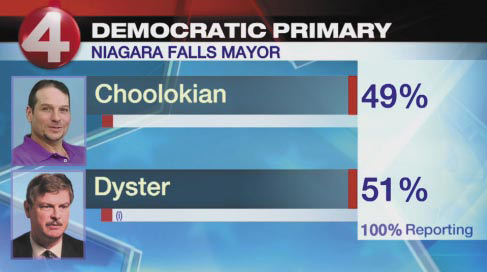
Dyster's Greatest Hits, Vols. 1 & 2 The Dyster ChroniclesDeborah EddelOCT 29, 2015 |
||||||||||
|---|---|---|---|---|---|---|---|---|---|---|
Totes McGoats may very well be remembered as the penultimate act of the political career of Paul A. Dyster, a national embarrassment that sort of came to symbolize, and even synopsize, eight years of goofy failures. However, Totes McGoats is precisely that: a shorthand for eight years of ineptitude that have managed to put Niagara Falls on the map again and again and again, but for all the wrong reasons. As voters go to the polls on Tuesday, it is the fervent hope of the Niagara Falls Reporter that they will remember the totality of the Dyster Record. To further that endeavor, we have pulled together this retrospective, a sort of Greatest Hits Vol. 1 & 2 of the man who just days ago proclaimed of his administration’s decision to send a rubber-masked convicted heroin dealer out to educate our children on recycling: “If the City of Niagara Falls wasn’t willing to hire people who have had drug convictions, where would they ever go?” The Dyster Chronicles: Paul Dyster, the Mayor, was born on Nov. 6, 2007. That night, he thrashed a former Niagara Falls councilwoman named Candra Thomason, the nominal candidate of the Falls Republican Party, by a 4-to-1 margin. It’s hard to imagine, after such a landslide, within months he would be bogged down, but he was. The Building a Better Niagara Falls Fund. Now, eight years later, it seems like a solid indicator of what was to come, but at the time, many cut Dyster enormous slack for managing to, within weeks of walking into City Hall, embroiling his government in its very first scandal. Dyster came to City Hall with a plan to hire extraordinary people for important positions such as city administrator and economic development director. He planned to use money from a “charity” funded by anonymous donors to pay the difference between what taxpayers could afford and what Dyster wanted to pay—between $30,000—and $50,000 more—bringing salaries above $100,000 for the first time in the city’s history. Naturally, it begged questions: Are these donors city residents? Do they live outside the city? What precisely could their motivation be? The most enduring question was: Were the donors’ identities secret to Dyster—or just everyone else? Venerable Niagara Falls Reporter journalist Mike Hudson got answers. He uncovered that the Buffalo Niagara Partnership—a one-sided partnership that favors Buffalo over Niagara—appeared to be behind some of the secret funding. That was troubling. Why would pro-Buffalo people care to pay for salaries in Niagara Falls? Next, the paper revealed that two of the Partnership’s prime Niagara Falls luminaries—James and Christopher Glynn, owners of the Maid of the Mist Steamboat Corp. and purchasers of the downtown Comfort Inn—may have been behind much of the secret money. The plan eventually died under its own weight, as the questions became too much for the public to bear. Donna Owens. So, what did Niagara Falls get for this investment? Dyster gave us City Administrator Donna Owens, formerly off Atlanta, with a hefty new $110,000 salary. What did Ms. Owens do in Atlanta, before being given day-to-day control of city government? She was deputy commissioner of the Office of Solid Waste Services for the Atlanta Department of Public Works. A fitting appointment, given Dyster’s tenure, to be sure, but shocking: the chief administrator for the City of Niagara Falls was to be the former Number Two garbage (wo)man for Atlanta. The symbolism wasn’t lost on many. Economic Development. Dyster pitched a $100,000 salary (to be largely funded by the Building a Better Niagara Falls Fund) for an economic development director to Council leaders in September of his first year. What did the city get for this hefty pricetag? Peter F. Kay, late of Perrysburg, Ohio. (It bears noting, here, that the straight-shooting Councilman Bob Anderson was already sounding the alarm about Kay and the high salary before he was even appointed.) Dyster chose Kay after his transition team conducted a six-month national search to fill the job. Dyster talked of big economic development ideas, including an ethanol plant that never came about. Perhaps the fact that Kay got his start in Jamestown—a city not often noted as an economic powerhouse—should have served as a warning of what was to come. After just 13 months, the City Council was already contemplating—openly—cutting Kay’s position and its salary. Meanwhile, Kay’s only significant accomplishments came not in what he developed, but in what he kept from being built. He quickly made headlines when he tried to block the development of two hotels on the Upper Niagara River by the Canadian firm of Merani Holdings. After that, Kay and his underling, City Planner Tom DeSantis, began a years-long campaign of harassment directed at then-One Niagara Building owner Frank Parlato. (Full disclosure: Parlato is the publisher of the Niagara Falls Reporter.) From trying to reduce the number of parking spots available for One Niagara customers to refusing certificates of occupancy for upper floors of the building, city government embarked on a crusade to restrict competition to Dyster’s campaign contributors. Economic development began sputtering so badly under Kay that the chairman of the Niagara County Industrial Development Agency once famously remarked, in a hot mic incident, “They don't need economic development, they need FEMA.” Finally, in exasperation, the City Council cut Kay’s salary—from $100,000 to $1—just to be rid of him and his empty promises. Ali Marzban. With eight years of hits, it’s easy to forget even some of the chart-toppers. But this article would be incomplete without rehashing the saga of Ali Marzban. Like Kay and Owens, Dyster’s (first) pick for city engineer was the product of Dyster’s prodigious efforts to search far and wide across the fruited plain to find the best and brightest. Marzban, hired 16 months into Dyster’s first term, was an Iranian immigrant from Los Angeles. At a mere $93,000, Marzban’s salary seemed like a bargain, compared with his peers. Of course, you get what you pay for. And in Marzban’s case, it turns out the city hired an engineer who was not licensed to practice engineering in New York state. Or, it seems, anywhere else. After the Niagara Falls Reporter brought this discrepancy to light, Marzban was cashiered by the Dyster Administration. On the job for just four months, though, Marzban left a legacy behind: The disastrous Lewiston Road reconstruction, a project that was to originally cost $7.7 million and wound up costing more than $16 million and finished two years late. Tom Radomski. After nearly half a year without a city engineer, Dyster hired his second city engineer: Tom Radomski. Radomski lasted for more than a year, and gets generally favorable marks from people who worked with him. Things were going swimmingly, until Dyster unceremoniously fired him for the cardinal sin of living just north of the city limits, in neighboring Lewiston. Dyster then hired LiRo Consultants, a firm that had contributed to his campaign, for outside engineering work—much of it larded up with cost overruns. They were involved, famously, in the city’s courthouse construction fiasco (but more on that later). Radomski, who had run up against LiRo brass and their project change orders one too many times, found himself unemployed. And Niagara Falls, again, found itself without a city engineer. Until…
Jeffrey Skurka. If the hardball tactics employed against Radomski were a bit much for you, then avert your eyes from the tale of Jeff Skurka, city engineer no. 3, hired half a year after Radomski’s January 2010 termination. Hailing from New Jersey originally, Skurka, who had been living in Western New York for half a decade, came in with solid credentials. Most importantly, unlike Marzban, he was a New York state licensed Professional Engineer. Skurka would spend the next year and a half trying, futilely, to get the Lewiston Road reconstruction project back on schedule. It was his efforts there that would also cost him his job. Skurka discovered a number of safety violations by a city contractor during a November visit to the project site. As city engineer, one might expect that such visits would be in the scope of his duties. He raised his objections, mostly centered on workers being sent into a 7-foot deep trench, warning the contractor that the trench was not constructed properly to prevent cave-ins. Skurka contends he was then ordered to stay away from the site by Dyster -- essentially, ordered to see no evil, hear no evil, and speak no evil by the Mayor. Skurka also raised objections about unlicensed city engineering department personnel engaging in design work—which, he noted, is a Class E felony in New York State. Skurka would ultimately be fired by mail for, it seems, not going along and getting along. He subsequently filed a lawsuit for lost wages against the city. Meanwhile, the company he had first run afoul of for safety violations, was later cited by OSHA after a lengthy investigation and fined $84,000 in federal court. Skurka would also be the last Dyster city engineer. Courthouse. It’s worth noting that Dyster launched the construction of a new Niagara Falls courthouse, or “Public Safety Building,” as its euphemistically know, during the year-and-a-half before hiring Marzban. Perhaps the lack of adult supervision can be blamed for what would happen here. The process—which, admittedly, began under Dyster’s predecessor, Vince Anello—began with a 2004 estimate from the state of $12 million to construct a no-frills courthouse. With Dyster, though, there are always frills. In the weeks before Dyster took office as mayor, giving up his seat as Councilman Dyster, the City Council voted to construct the facility and awarded the bid to LP Ciminelli. Ironically, enough, though, halfway through Dyster’s first year in office, this newspaper’s cross-town rival, the Niagara Gazette, ran an article with the headline “Niagara Falls: Can’t Put a Price on Public Safety Building.” Indeed, you couldn’t. The price continued to balloon. While once New York State estimated $12 million would be sufficient, and a more nuanced estimate of $22 million came from former state Sen. George D. Maziarz, and Ciminelli would estimate $34 million, the final pricetag was ratcheted up to $50 million. Driving this massive price spike were all the change orders—which, in many instances, came from Dyster contributor LiRo Engineers, Inc., of Buffalo, conveniently hired to be the project managers. (You remember LiRo, if you’re reading along, don’t you? The firm that is reputed to have gotten Dyster City Engineer No. 2 Tom Radomski fired for questioning all their cost overruns?) Among the most egregious of the cost overruns were $2,282 for a water valve and a $24,000 garage door blueprint. Still, the Dyster saga was far from over. In 2011, Dyster, reeling from punch after punch, went on to seek a reprise and—despite decades of contrary history in Niagara Falls—win a historic second term. After winning 4-to-1 over the underfunded Thomason in 2007, Dyster was challenged by a young, energetic Republican named Johnny Destino, who had been making a name for himself on the Niagara Falls School Board. After an explosive election night that saw nearly 9,500 voters come out, Dyster emerged on top, besting Destino by 665 votes. It was, in the political parlance, a “squeaker.” Strangely, Dyster chose the occasion of his narrow victory as the forum to tell his supports, “When you’ve got great people working for you, it’s easy to look good!” Not that his supporters were any less delusional. At Dyster’s frenetic victory rally, Councilman Charles Walker made this questionable observation: “People recognize that things are happening and we need to stay on track.” Ironically, that race also would lay the groundwork for this year’s mayoral race, as Dyster found himself joined in the winner’s circle by none other than Glenn Choolokian—a newly-minted councilman who would go on to challenge Dyster this year in a primary that was even closer than his ’11 squeaker. On primary night, Dyster would best Choolokian by a mere 63 votes in the Democratic primary. So, what have we heard in heavy rotation from Dyster’s Greatest Hits, Vol. 2? Hodgson Russ. Lots of Dyster campaign contributors have managed to get a solid return on investment, but at $828,428 for legal services since 2009, few have done as well as Buffalo-based Hodgson Russ. So, how does Hodgson Russ reward Dyster? In August, they threw a swank campaign fundraiser for the mayor. Nothing unseemly about that—a firm that profits any time the city kicks legal work their way deciding to give a little back. Pitchers and Catchers. Dyster doesn’t just screw up the big-ticket stuff. He also managed to screw up minor-league baseball. All Dyster had to do was reach reasonable terms with the Niagara Power minor league baseball team to keep them playing at Sal Maglie Stadium. Unfortunately, though, Dyster—whose tendency to pander to unions the Niagara Falls Reporter detailed last week—caved to city union pressure, and expelled the Power from the city’s diamond. Meanwhile, though, Dyster is banking on a future that speaks with a heavy South Asian accent, seeing to it that city taxpayer funds were appropriated to build a cricket field at Girard Avenue and 61st Street. Which places Dyster in a sticky wicket. The National Pastime is no longer welcome in Niagara Falls, but apparently cricket is. How did Dyster choose to gloss over his failures? By pandering. Because, well, because it’s Dyster: “Indian Americans are an important part of our culture now- and we’re always looking for ways to accommodate people,” Dyster said. “Cricket may be unfamiliar to a lot of us- but that doesn’t mean it’s not something that people enjoy playing, if we could find an opportunity for them to do that, we always want to accommodate.” We always want to accommodate. Unless it’s minor league baseball.
Bribing People to Live Here. The Niagara Falls Reporter has, admittedly, found most members of the Dyster inner circle less than impressive. But none are less impressive than Seth Piccirillo, the director of community development and Dyster campaign attack dog who went so far as to write an editorial blasting Choolokian ahead of the primary. Nowhere has Dyster’s penchant for kooky, liberal, New Age nonsense been as clearly on display as in his wholesale embrace of Picirillo’s brainchild: bribing recent college grads to live here. In a dying city with decaying neighborhoods, $200,000 in Urban Renewal Agency funds could do a lot of good, perhaps removing some of the massive blight that plagues the Cataract City. But not on Dyster’s watch. No, under Dyster/Piccirillo, that money was used to fund $7,000 personal grants to young college graduates who chose to rent or buy a home in Niagara Falls. The goal was to bring 20 new residents. Shockingly, they weren’t even obligated to stay, long-term. How did Picirillo defend spending $200,000 to lure, at best, 20 new residents? In a shocking fit of honesty, the city’s top economic development official declared in an interview with Rochester’s WXXI, “Are we doing anything else to bring 20 people in? No!” He then assured viewers that the 20 new residents would purchase “20 more cups of coffee.” Tim Horton’s, no doubt, is rejoicing. Of course, the 20 cups of coffee have yet to materialize. Three years on, the program managed to net just seven brave souls. But, hey, that’s seven more double-doubles at Timmy Ho’s. Declining Population. In fairness to Piccirillo, the goal of the previously-mocked program was admirable (even if the method was kooky): stabilizing a declining population to keep it from dipping below 50,000—the level at which various federal subsidies for so-called “small cities” suddenly become unavailable. However, the seven new residents just weren’t enough. The U.S. Census Bureau now estimates that the Falls’ population has dropped to 49,468. That’s a drop of more than 500 since the last time Dyster stood for election. But not all is doom and gloom… Sex Offenders Up. Figures being touted by several local Republican campaigns point to what has to be, in light of Piccirillo and Dyster’s objective of boosting the population, good news: today, one in 300 city residents is a registered sex offender—a figure regularly available on the website city-data.com. Even better, in just the last two years, the number of sex offenders in the Falls has climbed by 23 percent. At least, under Dyster, there is a growing segment of the population. Casino Money. Any Dyster retrospective would be remiss if it didn’t pause and reflect on the 2010 budget crisis, which, but for the state blinking in a battle with the Senecas at the last minute, threatened to put the city in default as Seneca Niagara Casino slot revenues dried up. At the time, city leaders were panicked because the loss of casino revenues threatened to “blow a $4 million hold in their budget,” in the words of a WGRZ news report at the time. So, having realized how risky budgeting based on casino revenues was, how did Dyster et al. react? One might assume they made the city less reliant on the unreliable stream of cash from a sometimes-hostile Indian casino enterprise. One would be wrong. This year, Dyster made a last-minute decision to raid casino funds to the tune of $12.5 million to, among other things, fill a $7 million budget deficit. This action brought condemnation from top fiscal experts, including the comptroller of neighboring Erie County, Stefan Mychajliw. “What scares me…is this is not the first time this has taken place in Niagara Falls under this present mayor,” Mychajliw says. “This budget is smoke-and-mirrors, and it’s a dangerous game they’ve been playing for several years.” Credit Downgrades. On Dyster’s watch, the city’s bond rating has been cut. So bad is it, that in 2011, Fitch Ratings gave the city an A rating with a stable outlook. Just last month, though, Fitch’s rating had been downgraded all the way to BBB. In their analysis, Fitch condemned the city’s reliance on “diverse but volatile revenues,” its “strained operating history,” “weak economic indicators,” and “high, fixed-cost burden.” The Fitch report also cast down on whether Dyster would ever be able to “reverse operating deficits.”
Totes McGoats. It always comes back to this guy, doesn’t it? In the waning days of the campaign, Dyster trotted out his mascot: Totes McGoats, a man in a rubber goat mask whose job it was to sell young children on recycling. Time magazine called the cheap costume “terrifying.” This newspaper noted its uncanny resemblance to the satanic demon Baphomet. The mascot was already being roundly ridiculed before—in classic Dyster fashion—it was revealed that the man behind the mask was a convicted heroin dealer with a long rap sheet. Dyster’s take? “If the City of Niagara Falls wasn’t willing to hire people who have had drug convictions, where would they ever go?” And, if the voters of Niagara Falls weren’t willing to elect men with no convictions, one wonders where Dyster would ever go.
|






